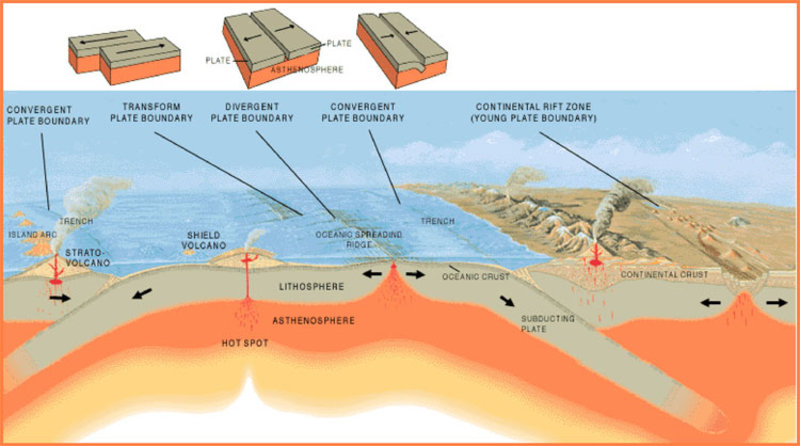7 Which of the Following Is Not a Convergent Boundary
A convergent boundary also known as a destructive boundary is an area on Earth where two or more lithospheric plates collide. 3 BASIC TYPES OF PLATE BOUNDARIES 2.

Convergent Divergent And Transform Boundaries Flashcards Quizlet
Oceanic-Continental convergent boundaries which occur when a continental plate and oceanic plate collide eg the Nazca Plate under South America.

. Kermadec Plate - Pacific Plate. As shown below the plates are made of rigid lithosphere consisting of the Earths crust and the uppermost. DIVERGENT PLATE BOUNDARY Using hands to show relative Motion DIVERGENT PLATE BOUNDARY where plates spread apart pull away or separate from each other as a.
Two converging oceanic plates meeting head-on and piling up into a mid-ocean ridge b. Form -infinity to 0 xx425dx. The Cascadia Subduction Zone extending from northern California through western Oregon and Washington to southern British Columbia is a type of convergent plate boundary.
At an ocean-ocean convergent boundary one of the plates oceanic crust and lithospheric. Two parallel mountain ranges have been forming as a result of the Juan de Fuca Plate subducting beneath the edge of North America. Which of the following is not a divergent plate boundary.
Convergent boundaries occur where the Earths tectonic plates collide or move toward one another. Continental lithosphere is of lower density and thus more buoyant. Creative writing is.
The landscapes of many National Park Service sites show convergent plate boundary processes that result in a variety of mountain ranges and complex geological structures characteristic of subduction zones accreted terranes and collisional mountain ranges. Question 13 1 point Which of the following is NOT a subduction zone along a convergent plate boundary. The activity at continent-continent convergences does not take place in the mantle so there is no melting and therefore no volcanism.
Fill in the blanks in the following sentences. 74 A transform boundary is characterized by _____. The pressure and friction is great enough at these boundaries that the material in.
The three types of convergent boundaries include. The amazing Himalaya Mountains are the result of. Convergent boundary movement is divided into two types subduction and collision depending on the density of the involved plates.
A convergent boundary or destructive boundary is where two plates are moving towards each other and colliding. This results in the creation of magma chambers at the subduction zones which might ultimately lead to volcanic eruptions and the formation of volcanic island chains in. Near the western edge of the continent.
See the answer See the answer done loading. An Introduction to Physical Science 13th Edition Edit edition Solutions for Chapter 21 Problem 7MCQ. When two such plates approach each other the older and hence the denser plate usually subducts beneath the other.
A divergent b convergent c reverse d transform. Large slabs of lithosphere smashing together create large earthquakes. Australian Plate - New Hebrides Fiji Plate.
1122022 122629 PM 4 Answers. The San Andreas fault d. These collisions happen on scales of millions to tens of.
S hare your worl d. One plate eventually slides beneath the other a process known as subductionThe subduction zone can be defined by a plane where many earthquakes occur called the WadatiBenioff zone. Which of the following is not a type of plate boundary.
Which of the following is NOT a type of plate boundary. The Great Rift Valley of East Africa b. Continental-volcanic IS NOT a convergent boundary Option D.
The East Pacific Rise c. Letters in ovals are codes for NPS sites at modern and ancient convergent plate boundaries. A convergent boundary might also feature two oceanic plates.
Somali Plate - Indian Plate. A convergent plate boundary occurs where two plates push against each other. Transform fault boundary 4.
CONVERGENT PLATE BOUNDARY CONVERGENT PLATE BOUNDARY where sections of Earths crust can come togethermove towards each other and collide. Faults and ocean basins volcanoes and mountains rift valleys and ridges hot springs and geysers. All of the above are types of plate boundaries.
Determine whether the integral is convergent or divergentIf it is convergent evaluate it. Which of the following is NOT a type of tectonic plate boundary 1. A divergent boundary where the continental plate changes to an oceanic plate c.
Thus the following convergent boundaries occur when two plates meet. Which land features are most likely found near a convergent plate boundary. As the plates converge the denser thinner tectonic plate subducts or dives beneath the lighter thicker more buoyant tectonic plate.
Convergent boundaries where two plates are moving toward each other are of three types depending on the type of crust present on either side of the boundary oceanic or continental. The types are ocean-ocean ocean-continent and continent-continent. North American Plate - Cocos Plate.
W I N D O W P A N E. A convergent boundary is a location where two tectonic plates move towards each other. Convergent boundaries also called destructive boundaries are places where two or more plates move toward each other.

Convergent Boundary Definition Facts Examples Video Lesson Transcript Study Com

What Are The Different Types Of Plate Tectonic Boundaries Exploration Facts Noaa Office Of Ocean Exploration And Research

Three Types Of Plate Boundaries Convergent Transform And Divergent Plate Boundaries Plate Tectonics Tectonic Plate Boundaries

Convergent Boundaries Plate Boundaries Plate Tectonics Science Fair Projects
No comments for "7 Which of the Following Is Not a Convergent Boundary"
Post a Comment